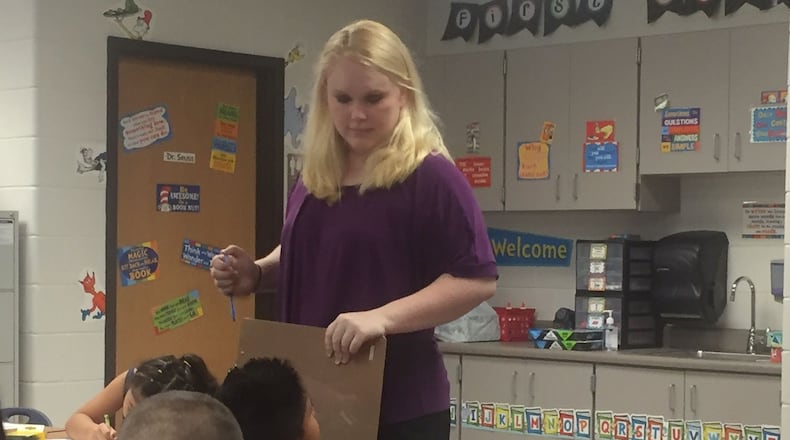Audrey Smith has never taught before.
On Monday, she arrived at Gwinnett County’s Baldwin Elementary School, one of two new schools that opened in the district, at 6:49 a.m. to begin her teaching career.
A former Gwinnett student, Smith, 25, got the desire to teach after working three years in a charter school in New York City. She’s been assigned to teach a class of first graders.
An Atlanta Journal-Constitution reporter and multimedia journalist are shadowing Smith on her first day.
3:30 p.m.
“Come on!,” Smith said to two students running down a hallway.
Their school bus was about to leave and they were about to miss it.
Smith wondered how they missed the initial call to get on the bus. Thankfully, the school bus doors hadn’t closed.
“Whoo!,” she said. “We got ‘em.”
Smith returned and escorted the final batch of students to their buses. After they left, she thrusted her arms triumphantly.
“They’re gone,” she said. “They’re all going home safely.”
Smith learned a few lessons Monday, such as teaching students to line up at recess and return to her before letting them play. She also wants to find more ways to “be kids.”
Smith said she won’t dwell on what she felt she could have done better.
“That’s the thing I think is so beautiful with this profession,” she said. “You can truly start fresh every day.”
2 p.m.
A potential crisis has developed. One boy stands in front of Smith with his arms folded, his head cast downward.
He refused to sit down.
Smith moved him aside. The boy twisted his hands over his eyes, ready to cry.
Smith gave instructions to the class to draw what they think will happen to David, the ill-behaved boy she read about to the class minutes earlier.
She returned to the boy and asked what’s wrong. He wants to go home. He asked for his dad earlier during the school day.
Smith showedhim the bus schedule.
“You only have this much more time and you’re going home,” Smith said.
She instructed the boy to join his classmates in drawing what his prediction of what will happen to David. He sat down and listens.
1 p.m.
Smith has spent much of the last few hours doing math.
“Fifteen, sixteen, seventeen,” she said repeatedly, counting each student in her class to ensure she hasn’t lost anyone.
The task seems simple, but it can difficult. She’s still trying to memorize their names. They only way she knows which students are hers are the name tags each student is wearing that has her name on it.
The students visited the school playground, playing alongside other first graders. Some teachers have whistles to alert their students to return to them. Smith doesn’t have a whistle. She watched them closely and waved her right arm, which is her signal that they need to stop playing.
Next was lunch. Afterward was a trip to the restrooms. Each time, she demanded they get in a straight line and be quiet.
Sometimes they do. Occasionally, they don’t.
“Wait,” she said. “Is my class talking in the hallway?”
Smith is constantly trying to teach her class how to find solutions. When one boy is unable to spell “turtle”, Smith directed him to a wall with a picture of the animal and its spelling.
“He’s using his resources to solve a problem,” Smith told the class.
Other students later do the same.
10:30 a.m.
Smith is getting to know her students, and they’re learning about her.
“I am from Georgia, just like you,” she saya.
Smith tells them more about her background, and her 2-month-old son Timothy, whose picture is on her desk and on a locker.
Smith gives the students their first exam. She asked them what’s her name? Most of them raise their hands and start to say it. No, she says. You have to wait to be called on first, Smith reminds the class.
Smith asked the students what’s her son’s name. They initially forgot. A few remembered and try to answer without raising their hands.
The teacher leads her class in a straight line through the hallways, marching past other students to another class and to the restrooms. While the students are in another class, Smith catches up on duties like making sure the students have the proper tags on their backpacks that show which school bus they’re supposed to ride when they go home.
Some students continue to trickle in. Seventeen of her 18 students are now here. Six-year-old Brooklyn Mckenzie arrived around 9:40 a.m. Smith tries to connect with her, saying she lived in Brooklyn, N.Y. before returning to Georgia. Brooklyn looks at her without reacting.
Smith explains to the students the rules of lunch. Clean up after yourself. No yelling in the hallway.
She tells the students it’s okay to make mistakes. Smith occasionally mispronounces some names of the students.
“This is the first day at Baldwin Elementary, so it’s up to you guys to make it great,” she said.
8:10 a.m.
The first school bell for the day rings.
“We are missing a lot of friends,” Smith said to her students.
Six students are in the classroom. Smith has 18 students on her roster. Classes are scheduled to begin at 8:15 a.m.
Smith has laminated name tags for each student. On each desk is a white sheet of paper with black lines that the students are supposed to color in specific colors.
Smith has soft jazz playing on a speaker in her classroom.
“It makes me anxious to have a classroom without any sound,” Smith explained.
The first student, Jaqueline, arrived at 7:50 a.m. She’s armed with two white plastic bags filled with school supplies. Smith directs her to put some of the items in her desk. Smith told Jaqueline to put on her name tag and to begin coloring.
Smith’s biggest hurdle thus far is remembering each student’s name.
“Don’t tell me. Your name is Aaron, right?,” she said.
The boy nodded his head affirmatively.
The students are quiet as they color. Smith gave the students instructions by explaining what they have done correctly. She thanked students for raising their hand.
“I like it when Lizbeth colors inside the lines,” she said.
About the Author
Keep Reading
The Latest
Featured

